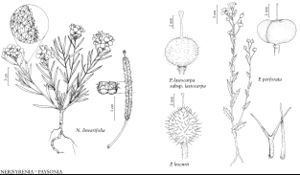Paysonia
Novon 12: 380. 2002.
Annuals or, rarely, biennials or perennials; not scapose; pubescent or glabrous, trichomes short-stalked, forked or subdendritic, often mixed with coarse, simple ones. Stems erect, ascending, decumbent, or procumbent, unbranched or branched. Leaves basal and cauline; petiolate or sessile; basal rosulate, petiolate, blade margins entire, dentate, or pinnately lobed; cauline sessile, blade (base usually auriculate or sagittate, sometimes amplexicaul), margins dentate to lobed. Racemes (several-flowered), often strongly elongated in fruit, (rachis straight). Fruiting pedicels ascending to divaricate or recurved, (straight or slightly curved), slender. Flowers: sepals (deciduous), suberect, ascending, or spreading, oblong, (equal), lateral pair not saccate basally, (margins membranous); petals yellow or white, broadly obovate, claw slightly differentiated from blade, (apex rounded, truncate, retuse, or emarginate); stamens (erect), tetradynamous; filaments dilated or not basally; anthers oblong or sagittate, (not apiculate); nectar glands confluent, subtending bases of median stamens, surrounding lateral stamens. Fruits silicles, subsessile or sessile, globose, subglobose, subpyriform, suborbicular, orbicular, elliptic, cordate, or obovoid, terete, flattened, latiseptate, or angustiseptate; valves (papery or leathery), not veined, glabrous or pubescent, (trichomes branched and/or simple); replum not flattened; septum complete, perforated, or reduced to a rim, (membranous); ovules 4–40 per ovary; style distinct, (persistent, slender); stigma capitate, entire. Seeds sub-biseriate, flattened, margined, orbicular, suborbicular, or oval; cotyledons accumbent. x = 7, 8, 9.
Distribution
sc, se United States, n Mexico
Discussion
Species 8 (8 in the flora).
Paysonia was segregated from Lesquerella (now Physaria) based on its different base chromosome number, presence of auriculate stem leaves, typically annual duration, trichomes that are neither stellate nor tuberculate, and phylogenetic analysis of DNA sequences. Some species of the genus have very limited distributions and are of conservation concern. Five (P. densipila, P. lescurii, P. lyrata, P. perforata, and P. stonensis) are known to be interfertile under experimental conditions, and some combinations form fertile hybrids in the field (R. C. Rollins 1988).
Selected References
Lower Taxa
Key
| 1 | Fruits orbicular, elliptic, or cordate | > 2 |
| 1 | Fruits globose, subglobose, subpyriform, or obovoid | > 3 |
| 2 | Fruits angustiseptate; fruiting pedicels recurved; cauline leaf blades: base cuneate to auriculate, not amplexicaul; filaments not dilated basally. | Paysonia lasiocarpa |
| 2 | Fruits latiseptate; fruiting pedicels divaricate or nearly straight; cauline leaf blades: base auriculate to sagittate, sometimes amplexicaul; filaments dilated basally. | Paysonia lescurii |
| 3 | Petals white or pale lavender; septums perforate or nearly absent | > 4 |
| 3 | Petals yellow; septums complete | > 5 |
| 4 | Fruits subpyriform, valves sparsely hirsute or glabrate; styles glabrous. | Paysonia perforata |
| 4 | Fruits subglobose, valves densely hirsute; styles hirsute, at least proximally. | Paysonia stonensis |
| 5 | Fruit valves pubescent; styles glabrous or pubescent proximally. | Paysonia densipila |
| 5 | Fruit valves and styles glabrous | > 6 |
| 6 | Fruits 3-4 mm; ovules 4-8 per ovary; septums opaque. | Paysonia lyrata |
| 6 | Fruits 4-6(-8) mm; ovules (8-)12-28(-40) per ovary; septums translucent | > 7 |
| 7 | Stems hirsute proximally, trichomes simple; petals 4-5 mm wide. | Paysonia auriculata |
| 7 | Stems pubescent proximally, trichomes branched; petals 6-9 mm wide. | Paysonia grandiflora |
"elongated" is not a number."thick" is not a number.
